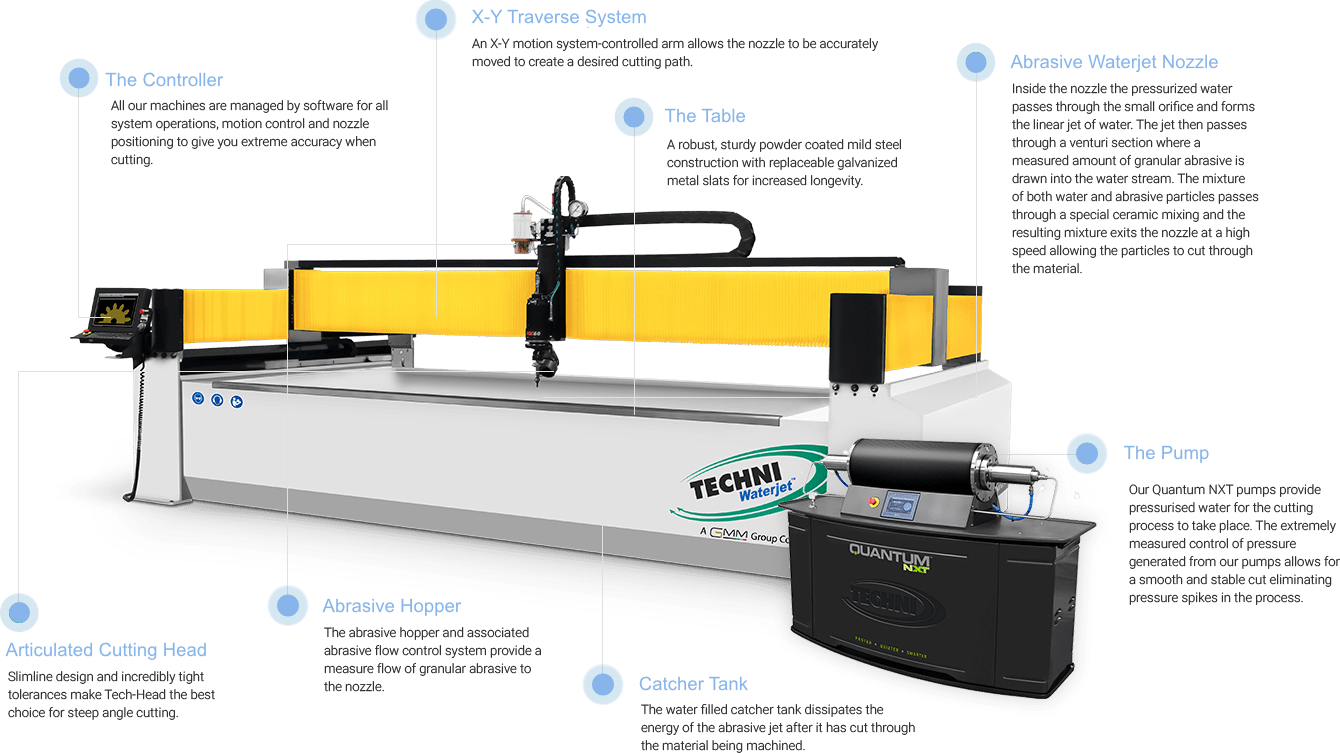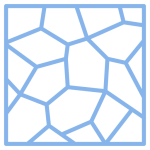LEARN MORE
ABOUT WATERJET CUTTING
What is the process?
Waterjet cutting is simply an accelerated erosion process within a selected material. Highly pressurised water is fired through a ruby or diamond nozzle into a mixing chamber. This pressure creates a vacuum and draws garnet sand into the stream where it is then fired at the object in place for cutting. The sand particles eat away at the material causing the effect of erosion to take place at such a high speed it is deemed as cutting. This has allowed waterjet cutting to become an extremely powerful and versatile tool that is used in many industries around the world.
WHAT IS A
WATERJET CUTTER?
A waterjet cutter is a machine that is made up of three main components to utilise a high-pressure stream of water to erode a narrow line within a piece of material. Depending on the material’s density and compound such as titanium a granular abrasive is added to the waterjet to increase the cutting power. The abrasive is added at the nozzle so that a simple switch between only water and abrasive cutting can be made.

WHAT ARE THE
BENEFITS OF USING WATER CUTTING?
Waterjet cutting offers manufacturers with versatility and flexibility like no other. The range of benefits associated with using waterjet cutting is what gives this technology its edge over its competition such as laser and saw cutting.
WHAT MATERIALS CAN BE CUT?
Waterjet cutting is becoming more popular around the world because of the versatility and the benefits it can provide to a wide range of industries. Learn about the range of applications that this waterjet cutting process can provide to your industry, business or production line.

Stone & Tiles
With its ability to easily cut to size, mitre edges, cut sinks and make tap holes in one operation, waterjet is becoming an all in one solution to kitchen and benchtop manufacturers.
The wet cutting process eliminates the risk of inaccurate cuts, dust emissions, heat zones and burnt edges so that benchtops can be manufactured right the first time. A full range of products can be cut quickly such as reconstituted engineered stone, porcelain, marble and granite meaning bottlenecks within products are no longer experienced.

Glass
Waterjet cutting has become an extremely fast process when cutting glass compared to traditional methods. It is now commonly known as the industry standard as method of choice because it is the most cost-effective way of processing full pieces of glass which require shaping or internal cut outs. Other traditional methods such as CNC machining are often too slow when cutting glass causing bottlenecks in companies production lines.
As glass is quite a brittle and fragile material, the cold cutting process works perfectly for making intricate cuts without causing cracks or microcracks within the material.
Commonly manufactured
PowerPoint Cut Outs | Kitchen and Bathroom Splashbacks | Frameless Shower Screens | Mirrors | Tabletop Inlays | Coffee Table Designs | Window Panels

Metal
Metal fabricators are choosing waterjet over other alternative methods in their day to day part cutting operations. Waterjet provides fabricators and other manufacturers with an extremely versatile cutting process that allows you to cut your full range of metal material with one tool. The cold cutting process once again is where waterjet sets itself apart within metal fabrication as it can cut parts to high tolerances with no heat stain and no secondary finishing.
Types of metal material
Aluminium | Stainless | Copper | Hardened Steels

Food
Waterjet cutting has become predominate within the food industry because of the safety it provides with preventing cross contamination for occurring between foods. It is also proving to be an ideal method of portioning foods because of the accuracy of the cuts. For large food corporations this provides amazing savings on time, increases product shelf life and provides and extra level of safety as blades are not being used to cut the foods.
Common Food Industries
Meat | Poultry | Vegetable | Fruits | Frozen Food | Cakes & Desserts

Aerospace
In an industry where there is no margin for error the precision required within this manufacturing process is second to none. Waterjet cutting is used to make components for jet engines and turbine blades as well as composite materials for aircrafts because it undoubtably delivers this type of precision every single time. The absence of heat affected zones in waterjet cutting means that there is no danger of microscopic cracks or warping’s that could potentially be life threatening. The adaptability that waterjet provides means that parts can be cut and manufactured to scale.

Automotive
Automotive manufacturers use waterjet cutting because of the benefits it provides in being versatile with cutting different components such as headliners, door panels, carpets all from the one machine. In addition, these material types can be cut with speed and accuracy without having to change anything but the cut software programming.
Some of the materials required to be cut within the automotive manufacturing process can be deemed as hazardous if they are affected by heat zones. Many manufactures face safety compliances to be met because of the toxic fumes that can be caused by cutting these materials with alternative methods. Waterjet cutters eliminate all of these risks because of the cold cutting process that is used when cutting objects.
Smooth and rough free edges mean manufacturers can cut once and expect a finished product, speeding up workshop efficiency in getting the car from design to on the road in a shorter amount of time.

Composites
Composite materials are reinforced for greater strength so cutting these materials requires a different approach than cutting metal materials. Traditional techniques are often found to be non-profitable as conventional cutters will cause the parts to wear out and require quicker replacement. Because Waterjet cutting uses an erosion process composite material can be cut without facing the likelihood of the material losing its strength, making it more suitable for applications in the medical and aerospace industry.


